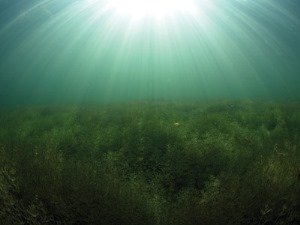EPA Science Matters Newsletter: How Deep Are the Seagrasses?
EPA researchers are studying seagrasses to help Florida set water quality standards.

Nutrient pollution is the primary cause of water quality impairment throughout Florida. The State is developing water quality standards for nutrient pollution to protect and restore the quality of its waters. To support that effort, EPA researchers are conducting studies focused on seagrasses.
Nutrient pollution entering Florida’s estuaries—where rivers meet the ocean—sparks excess amounts of algae growth, which can threaten entire ecosystems.
“I think of the algae in the water as kind of a soup, and when you add nutrients, the soup becomes increasingly chunky,” says EPA ecologist Jim Hagy, Ph.D. “That is one mechanism by which nutrients can negatively affect seagrasses; they make the water less clear.”
Seagrasses, which grow on the bottom of estuary waters, need ample sunlight for growth. If enough light cannot penetrate the “chunky soup” overhead, seagrasses will die. Over the past 60 years or so, nutrient pollution has increased in many of Florida’s estuaries. Years ago, waters that were once clean and clear supported seagrasses in deep waters. Today, since the water is not as pristine, seagrasses are only found in shallower waters.
The change in depth of seagrass growth over time gives scientists a good way to monitor water quality conditions. They can compare healthy conditions (seagrasses at historical depths) versus unhealthy conditions (seagrasses only at shallower levels) of waters polluted by nutrients. EPA scientists are studying this phenomenon to help inform state nutrient control policies.
The status of water quality with respect to nutrients is evaluated relative to something called “numeric nutrient criteria,” which is a key part of water quality standards.
“Think of numeric criteria as a threshold beyond which problems are likely to occur,” explains EPA biologist Rick Greene, Ph.D. “It’s the concentration or numeric value of nitrogen and phosphorus (but could include chlorophyll, water clarity, or other parameters) necessary to stay below in order to protect a designated use of a waterbody.”
Healthy seagrass beds provide habitat for a wealth of marine organisms, including serving as vital nursery areas where many species whose young start out life small and vulnerable grow large enough to become important commercial and recreational resources, such as sport fish, crustaceans, and shellfish. Seagrasses also reduce wave action during storms, improve water clarity by trapping sediments, stabilize the bottom, and provide food for many marine animals and birds.
EPA’s involvement with nutrient criteria development in Florida began in late 2008. After exploring other factors, researchers recognized that linking nutrient concentrations to water quality requirements for seagrasses would be critical for criteria development.
“[Seagrass] habitats are present in most estuaries in the State, and there’s a lot of research showing that areas with seagrasses have a lot more biodiversity, a lot more productivity. With this in mind, EPA and the State both agreed that nutrient criteria should ensure that the water quality would support seagrass growth,” says Hagy.
While some seagrass research exists, there has been no comprehensive analysis of seagrass depth across the state using the type of consistent methodology that would be ideal for informing criteria development.
“The essential problem was to figure out through time, how deep have seagrasses grown?” says Hagy. “Our goal would be to establish water quality criteria that would enable seagrasses to grow at the depth that they used to grow at.”
Hagy looked at about 100 estuary segments across Florida and examined seagrass maps from as far back as 1940. Using these maps, he could determine how deep seagrasses once grew and how deep they are growing today. Hagy based water quality guidance on the healthier historical water conditions which allowed for seagrass growth at greater depths. His results were used in EPA’s nutrient criteria proposal for Florida that came out last November. The state of Florida is developing its own proposals, also using Hagy’s results.
“The method I developed for calculating depth of colonization would make that particular measure something that we could routinely assess any time we have a map of seagrass cover. It’s that easy now,” remarks Hagy.
In addition to aiding the state of Florida, Hagy’s research has paved the way for establishing nutrient pollution related water quality targets in other areas where seagrasses are prevalent and depth of colonization could be a useful measure of habitat status.
